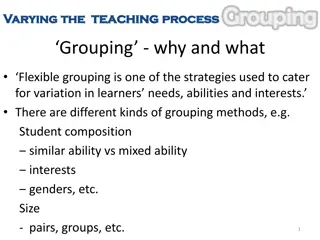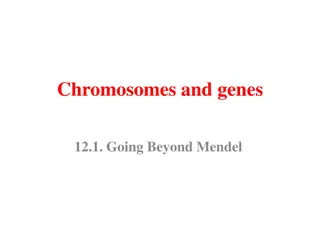Transfusion
Blood transfusion is a crucial medical procedure worldwide, with various components like packed red blood cells, plasma, platelets, and cryoprecipitate being utilized for efficient use. Differential centrifugation is employed for component preparation, ensuring precise separation of red blood cells,
2 views • 45 slides
Comprehensive Overview of mCLASS DIBELS/Lectura Interim Assessment Team
mCLASS DIBELS/Lectura is a comprehensive interim assessment program designed to help educators measure student progress in reading proficiency. The program includes Benchmark assessments, Progress Monitoring tasks, reinforcement activities, specialized grouping, and instant access to scores. With a
2 views • 48 slides
Understanding Human Blood Groups and Genetics
Human blood groups are determined by the presence or absence of specific antigens and antibodies. The ABO system categorizes blood into four types (A, B, AB, O), while the Rh factor (D antigen) determines whether blood is RhD positive or negative. Blood group antigens are crucial for safe transfusio
2 views • 14 slides
Comprehensive ABO Clinical Exam Domains Assessment for School Case
This presentation covers the evaluation of ABO clinical exam domains in a school case scenario, including data gathering, treatment planning, implementation, critical analysis, and outcomes assessment. Various images illustrate the different aspects of the assessment process.
2 views • 14 slides
Understanding Blood Groups and Their Significance
Human blood types are determined by specific antigens and antibodies present on red blood cells, influencing crucial aspects like blood transfusions and familial relationships in forensic medicine. The ABO system, with its four main blood types (A, B, AB, O), plays a vital role in categorizing blood
7 views • 14 slides
Understanding Boolean Algebra: Duality Theorem, De-Morgan's Law, and Don't Care Conditions
Boolean algebra concepts such as the Duality Theorem, De-Morgan's Law, and Don't Care Conditions are essential for digital circuit design. The Duality Theorem states the relationship between a Boolean function and its dual function by interchanging AND with OR operators. De-Morgan's Law helps find t
0 views • 10 slides
Understanding Anxiety Disorders in DSM-5
Anxiety disorders encompass a range of conditions, from separation anxiety to social phobia and generalized anxiety disorder. The DSM-5 has re-conceptualized these disorders, grouping OCD in its own category and moving PTSD to trauma-related disorders. Recognizing symptoms and seeking appropriate tr
1 views • 96 slides
Understanding Body Plans of Animals in the Animal Kingdom
Introduction to the diverse phyla within the Animal Kingdom, highlighting key features of body plans such as symmetry, cephalization, tissue layers, coeloms, and gut types. Exploring the classification system through common characteristics shared within phyla and the significance of morphology in gr
1 views • 54 slides
Spatial Distortion Correction in EPI Sequences: Field Mapping Examples
Spatial distortion artifacts in EPI sequences (BOLD or DWI) due to slow sampling rates in the phase encoding direction can be corrected using B0/spatial field mapping techniques. This correction requires obtaining field maps under the same B0 shimming conditions and with identical FoV and adjustment
0 views • 4 slides
Understanding Cladograms and Phylogenetic Analysis
Cladograms are used in cladistics to illustrate evolutionary relationships between organisms based on shared ancestral and derived characters. They are created by grouping species by common descent, forming clades that include an ancestral species and all its descendants. Valid clades are monophylet
0 views • 11 slides
Understanding Filesystems: A Comprehensive Overview
File systems provide a structured approach to storing and organizing data on secondary storage devices. They involve logical organization of files, directories for grouping related files, sharing data between users, and managing permissions. Files contain data with attributes like size, ownership, a
3 views • 29 slides
Understanding Order of Operations with Parentheses
Explore the importance of grouping symbols in numerical expressions with parentheses, brackets, and braces. Learn how to identify and evaluate expressions following the PEMDAS rule and the funnel method. Master key vocabulary and solve problems involving order of operations in mathematical expressio
1 views • 41 slides
Understanding Material Classification and Properties in Science
Explore the importance of grouping materials based on their properties, such as appearance, hardness, solubility, density, and transparency. Discover how materials are classified and grouped, benefitting us in organization, efficiency, and study. Learn about the significance of material characterist
0 views • 15 slides
Exploring Proverbial Pairs in the Book of Proverbs
Delve into the organization and interpretation of proverbial sayings in the Book of Proverbs, examining the context, grouping, and intent behind the collection. Discover prevalent pairs, cohesive variations, and modern twists on traditional proverbs like "Absence makes the heart grow fonder" versus
0 views • 41 slides
Understanding Blood Groups, Clotting Time, and Bleeding Time in Medical Practice
This informative material delves into the significance of determining blood groups, clotting time, and bleeding time in medical settings. From explaining the ABO and Rhesus systems to outlining the practical objectives and procedures for the assessments, this resource aims to enhance understanding o
0 views • 34 slides
Understanding Numeration Systems in Indian and International Number Writing
Explore the differences between Indian and International Numeration Systems used for writing numbers. Indian system uses ones, tens, hundreds, thousands, lakhs, ten lakhs, and crores with commas to mark each digit grouping. International system includes ones, tens, hundreds, thousands, and millions.
0 views • 10 slides
Overview of Bentham and Hooker's Classification System in Plant Taxonomy
Bentham and Hooker's system of classification in plant taxonomy, outlined in Genera Plantarum, provided detailed descriptions of families and genera based on original plant dissections. This classification system has practical value for plant identification, with keys for taxa and subdivisions for l
2 views • 47 slides
Important Information for Year 5/6 Students and Parents
This document contains essential details for Year 5/6 students and parents, including information about the end phase team, curriculum coverage, grouping in Maths and English, water bottle policy, homework expectations, P.E. schedule, and a vocabulary list for years 5 and 6.
0 views • 7 slides
Support Strategies for Schools During the COVID-19 Pandemic
In response to the challenges brought by the COVID-19 pandemic, this guide offers support strategies for schools, emphasizing the importance of adapting teaching methods, providing targeted support, and implementing wider strategies to benefit all students, especially those disadvantaged. The guide
1 views • 13 slides
Understanding Antigen-Antibody Reaction: Agglutination Tests and Coombs' Antiglobulin Test
Learn about the principle and types of agglutination tests, including slide and tube agglutination, used for identifying bacterial isolates and blood grouping. Discover the importance of Coombs' test in detecting incomplete antibodies. Explore the applications and techniques involved in these immuno
2 views • 13 slides
Understanding Agglutination Reactions in Immunology
Agglutination reaction is a key technique in immunology where particulate antigens and antibodies clump together in the presence of electrolytes. This reaction is highly sensitive and often used for antibody detection, bacterial identification, blood grouping, and cross-matching. The process involve
0 views • 20 slides
Target Setting for Geography Session to Enhance Learner Performance
Informed by analytical reports, the target setting strategy aims to increase learner attainment in geography, with a goal of 80% achieving a distinction and 30% passing. Responsibilities include providing resources, implementing strategies before exams, and focusing on learners' strengths. The diffe
0 views • 14 slides
Blood Grouping Techniques: Methods and Advantages
Various blood grouping techniques including slide or tile method and microplate technique are discussed. Advantages of microplate ABO grouping such as cost-effectiveness, automation potential, and reduction in errors are highlighted. The use of different manual methods and newer techniques in blood
0 views • 11 slides
Understanding ABO Blood Grouping and Rh Groups
ABO blood grouping and Rh factor testing are crucial for blood transfusions and forensic medicine. The presence or absence of specific antigens and antibodies in human blood determines blood type. Genetic inheritance from parents establishes blood type, with codominance influencing offspring phenoty
0 views • 13 slides
Why Do We Match Blood for Patients?
Blood matching for patients is crucial to prevent adverse reactions like hemolysis and death. ABO and RhD compatibility testing are fundamental, along with selecting antigen-negative units for patients with clinically significant antibodies. Beyond mandatory requirements, matching can be complex due
0 views • 9 slides
Understanding Rh Immunization and Blood Group Incompatibility
Rh immunization and blood group incompatibility can lead to serious complications in fetuses and newborns. The ABO and Rhesus systems play crucial roles in determining blood group compatibility. Rh-positive red cells of the fetus entering the maternal circulation can trigger immune responses, leadin
0 views • 65 slides
Enhancing English Classrooms through Flexible Grouping Strategies
Strategies for grouping students in English classrooms are explored, focusing on the benefits of flexible grouping to cater to diverse learner needs. Various grouping methods, such as mixed ability and similar ability groupings, are discussed alongside a lesson example on exploring different aspects
0 views • 32 slides
Understanding Genetic Inheritance: Going Beyond Mendel
Exploring genetic inheritance beyond Mendel's principles, this content delves into topics like incomplete dominance, codominance, pleiotropy, epistasis, and multiple alleles. Discover how genes interact to shape phenotypes and learn about interesting genetic phenomena like Marfan syndrome and the AB
0 views • 20 slides
Digital Transformation in Supply Chain: Insights from Industry Experts
Explore the significance of digital transformation in supply chain management through expert insights from industry leaders like Michael Lynham and Dr. Waleed Abo-Hamad. Discover key components, drivers, and case studies showcasing the evolution and benefits of digital supply chains. Gain a deeper u
0 views • 28 slides
Understanding Antibody Screening and Pre-Transfusion Tests
In-house cell panel development, pre-transfusion compatibility testing, antibody screening methods, and the importance of ABO and Rh typing are discussed in detail. Steps for safe blood transfusion, reverse ABO grouping, AST testing for irregular antibodies, and selection criteria for screen cells i
0 views • 28 slides
Algebraic Expressions Lesson Overview
This lesson focuses on writing and reading algebraic and written expressions with grouping symbols and less than. Students will learn how to translate expressions containing groupings and less than. The lesson is designed to build on the previous day's lesson and challenge students' thinking. It set
0 views • 25 slides
Challenges in Managing O- Red Cell Component Blood Supply
Addressing the challenges of managing O- red cell component blood supply involves considerations such as compatibility rules, absolute and relative indications, EBA benchmark comparisons, data monitoring, case studies, D variant specifications, and recommendations for transfusions. The supply side c
0 views • 39 slides
Optimizing Multi-Party Video Conferencing through Server Selection and Topology Control
This paper proposes innovative methods for multi-server placement and topology control in multi-party video conferences. It introduces a three-step procedure to minimize end-to-end delays between client pairs using D-Grouping and convex optimization. The study demonstrates how combining D-Grouping,
0 views • 13 slides
ABO-Incompatible Heart Transplants: History, Rationale, and Outcomes
ABO-incompatible heart transplants have become a crucial option due to limited pediatric organ donors. The rationale behind such transplants includes the development of antibodies post-6 months. Despite detectable donor-specific isohemagglutinins, successful outcomes have been achieved. Current crit
0 views • 17 slides
ABO Clinical Examination Guidelines at Scantron Testing Centers
This document provides crucial information for examinees taking the ABO Scenario-Based Clinical Examination at Scantron Testing Centers. It covers exam format, time allocation, question structure, guidelines for answering, and rules regarding exam conduct. Examinees must follow instructions carefull
0 views • 37 slides
Understanding Gene Hunting and Disease Genes in Human Genetics
Gene hunting involves finding genes responsible for diseases by statistically linking them with markers on chromosomes. This process relies on the logical structure of chromosomes, genotypes versus phenotypes, recombination phenomena, and specific loci like the ABO locus on Chromosome 9. By analyzin
0 views • 18 slides
Enhancing Logical Grouping Mechanisms in Haystack Labs
Formalizing a logical grouping mechanism to standardize practices, promoting extensibility and alignment with existing work in Haystack Labs. Examples illustrate the flexibility and advantage of the system.
0 views • 9 slides
Understanding Blood Compatibility for Safe Transfusions
This presentation delves into the critical topic of blood compatibility for safe transfusions, covering aspects such as ABO and Rh blood groups, clinically significant antibodies, and potential incompatibilities. The session aims to enhance understanding of antigens, antibodies, and the risks of mis
0 views • 44 slides
Modification of ABO Subtyping References for Consistency Operations and Safety Committee
The current OPTN policy has inconsistencies in terminology, potentially causing confusion. Proposed solutions aim to clarify requirements for efficient management. Public feedback and resolutions show support for modifications to various policies. Contact information for queries is provided at the e
0 views • 8 slides
Pre-Analytic Errors in Transfusion Process at VUMC Blood Bank
The case study discusses a 16-year-old female involved in a motor vehicle collision needing emergent transfusion support at Vanderbilt University Medical Center. Issues such as mixed field identification and blood type discrepancies were encountered, leading to the importance of using universal dono
0 views • 23 slides







































